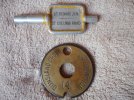The 'balancer' device was an expensive add-on no doubt, usually only employed where an imbalance occurred routinely and developed very quickly, such as at a NSTR passing loop like Eggesford where withdrawals and insertions almost exclusively occur at different instruments. Plausibly, a balancer can be used by a suitably trained operating staff member with no technical knowledge, whereas the manual lock-pick method can clearly only ever be performed by a qualified S&T technician.
The imbalance could commonly occur on lines where assisting engines went one way on double-headed trains, but returned light engine separately to the train. The Taunton to Barnstaple line regularly got this in the summer, where Taunton 43xx would work down to Ilfracombe in varying combinations on Saturdays assisting the holiday trains. I never knew how the rebalancing was done, but did hear that on one or two odd occasions there had been severe delays because the tokens had run out at one end.
I was reprimanded on a thread here a while ago for describing how, in the quiet hours of a Sunday morning, the signalman would get out the brass disc tablets and polish them up a treat with Brasso. Yes, there was a formal key for the token instrument, which only the S&T technician could get at, all having to be written up in the register etc. Unfortunately Mr Tyer never noticed that the standard issue poker for the coal fire perfectly fitted the lock as well ...
Here are a couple of exhibits from my wall at home, having been in my possession since they became redundant in the mid-1960s. That's a GWR pattern key token above, and a brass (as in Brasso, and occasionally given a very 21st-century polish-up by Mrs Taunton) Southern tablet below. The actual key end of the key token that operated the token machine lock has been sawn off by Exeter S&T on the section being closed, that was their standard approach whenever there were changes. GWR/WR always painted their tokens in different colours (blue/green/red/yellow) for adjacent sections, that's still the original paint on it.



